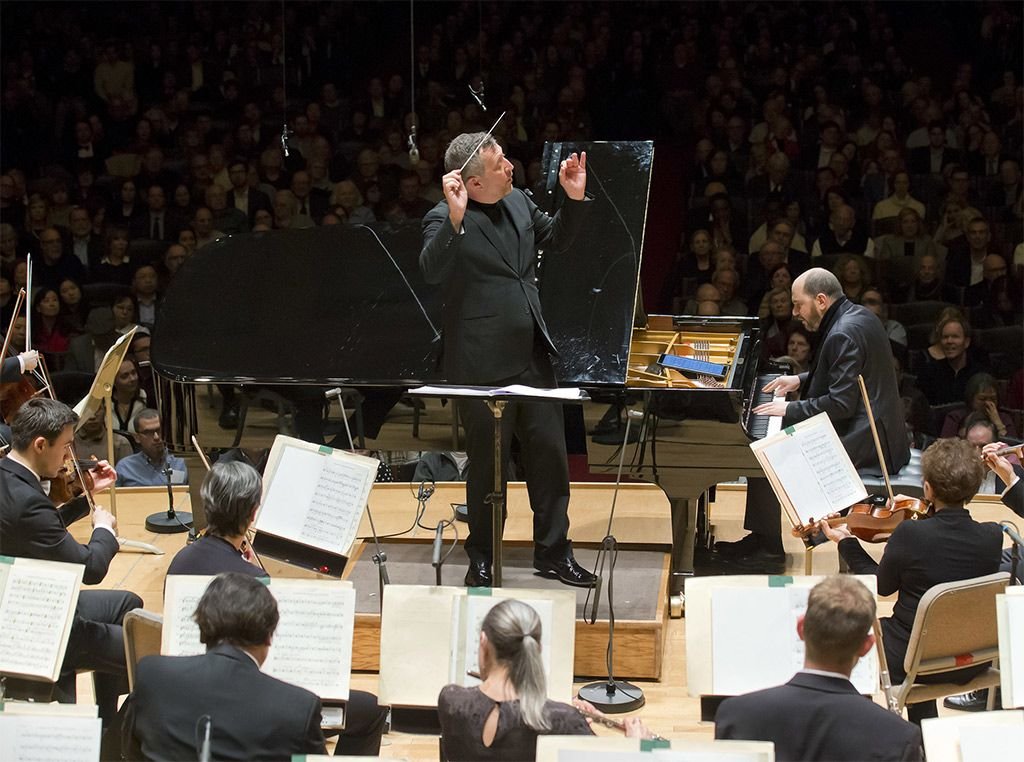Adès and BSO: 'A Proper Piano Concerto'

Photo by Winslow Townson.
The last few decades have been remarkably favorable for the piano concerto. Far from being quashed by mid-century modernism, the three-hundred-year old genre has been witnessing something of a renaissance, with composers from Esa-Pekka Salonen to Unsuk Chin pushing it in novel and exciting directions. The BSO introduced a new addition to this flowering corpus just last week: Thomas Adès’ long-awaited Concerto for Piano and Orchestra, performed by pianist Kirill Gerstein with the composer conducting.
Mr. Adès reportedly told Mr. Gerstein that his latest work would be “a proper piano concerto”–and indeed, this curiously conventional work was exactly that. Following the traditional fast-slow-fast formula, the three-movement work tended to fit the composer’s description by scrupulously adhering to the genre’s eighteenth-century structure. Whereas many of Mr. Adès’ previous works, like the Piano Quintet, subverted historical forms to brilliant effect, the Piano Concerto demonstrated just how well the music of today could function within the bounds of a well-worn framework.
The concerto lurched into action on Saturday with a theme that sounded like the chorus of “ABC 123” on LSD. Stumbling helter-skelter over irregular time signatures, the melody and its imaginative instrumentation alluded heavily to the opening movement of Ligeti’s Piano Concerto. Unlike the latter, however, Mr. Adès soon introduced a second theme that set the stage for a sonata-allegro treatment of the material. The BSO, meanwhile, enveloped the piano in a detailed cloud of figurations whose virtuosic demands were met in spades by members of the orchestra. The intricate swirl of sonorities fell silent only by the end of the development section, when they acceded at last to the cadenza. Rolling gestures ascended the keyboard in ebbs and surges as Mr. Gerstein bravely tackled the solo part–one which might easily rank among the most technically difficult in the piano concerto literature. After the restless ascent of the cadenza, the orchestra erupted into a bright, carnivalesque recapitulation that tumbled toward the tonic chord.
The second movement began with a solemn brass chorale, evoking the plaintive passacaglia from Shostakovich’s first Violin Concerto. Somber, quartal chords grew increasingly dissonant until they gave way to the piano, intoning the chorale under the ghostly halo of tuned gongs. Mr. Adès had used these gongs in his earlier work Asyla to great effect, and in this section of the concerto, they lent an uncanny aura to the soloist’s chordal elegy. A free-wheeling melodic variation over the chord progression followed the opening; though Mr. Gerstein played this passage with great feeling, the solitary line sketched out by his right hand sounded rather thin and feeble against the tutti’s throbbing pulsations. After the variation, traces of the eerie night music from Bartók’s piano concerti infiltrated the texture, as ostinato patterns in the piano circled insistently against heaving breaths from the orchestra. A final, shuddering iteration of the theme disintegrated at the movement’s end, leaving the piano to conclude with a bleak B♭ minor chord.
Mr. Adès wasted no time in jumping into the finale, which was announced by three short outbursts on brass. The Ravel-like fanfare was followed by cascading fifths on the piano–a hallmark of the Adèsian idiom–while the orchestra revved up with slithering glissandos. A frolicking melody soon emerged out of the introduction, played with vertiginous energy by Mr. Gerstein and the BSO. This was followed by a sequence of episodes, each of markedly different character, progressing in almost rondo-like fashion. One seemed to mimic the suspensions found occasionally in Mozart piano concerti; another was vaguely suggestive of chromatic sequences in works by Chopin or Rachmaninoff; another appeared to reference, rather inconspicuously, contrapuntal passages in the Beethoven sonatas. At the end of these allusive episodes, the principal melody of the movement returned, this time with canonic imitations trailing close behind. Palm clusters on the piano yielded to ebullient F-major scales as the orchestra burst into a glistening tutti variant of the suspensions heard earlier in the movement. A final, halting run, like a machine winding down, carried the concerto to a brilliant close.
While the premiere of the piano concerto was arguably the centerpiece of the concert, Mr. Adès and the BSO also did justice to the other works of the evening. Liszt’s Mephisto Waltz No.1 was given an energetic, mercurial interpretation by both conductor and orchestra, with excellent solos delivered by principal cello, violin, and flute. Although Tchaikovsky’s Fourth Symphony tended to suffer a bit from a lack of sufficient dynamic gradation in the louder moments, Mr. Adès brought great rhythmic acuity to its phrasings and syncopations, making for a stimulating rendition of the work. The strengths of this approach showed particularly in the final movement, when it propelled the music to a glorious finish.
Audience members, as usual, thunderously applauded after the Tchaikovsky, which still remains a staple of the classical repertoire 140 years after its premiere. Following last Saturday’s concert, Mr. Adès’ piano concerto may also, one day, belong in that canon as well.
Daniel Shin is a Producer for WHRB Classical. You can hear his feature Remembering the Future on Thursday evenings from 7-8pm.